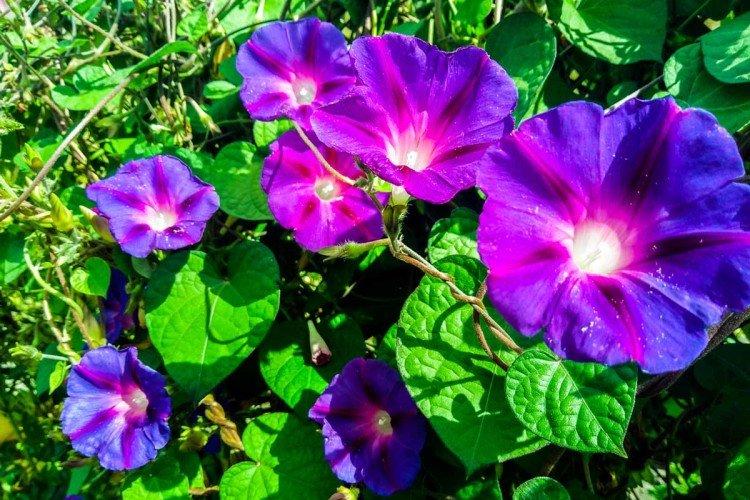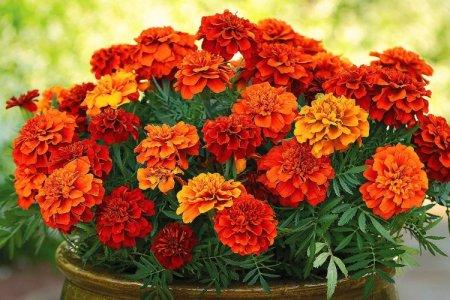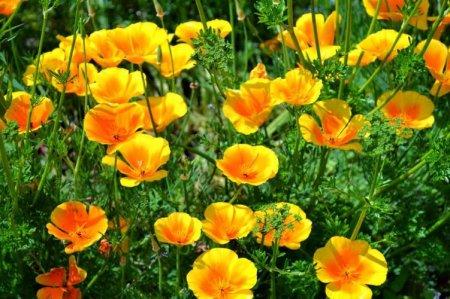
That adorable garden bindweed is actually called morning glory. She was also very romantically nicknamed the moonflower. And this time we have collected detailed information on the care, planting and growing of this graceful plant!
general information
It is difficult to give a general description for the morning glory, because its varieties are very different. But most of them are bindweed or vines, with delicate funnel-shaped flowers and large lobed leaves. The most common colors are all shades of white, blue and purple.
Ipomoea buds open in the morning as soon as the sun's rays hit them. So by the time you wake up, a lush blooming carpet will already be waiting for you. There are decorative deciduous varieties, but they are not very common.
Morning glory blooms by mid-summer, and blooms in waves until the first frost. The diameter of the opened bud reaches 12 cm. Small tubers can form on the rhizomes, and in some regions they are even eaten.

Ipomoea species
There are more than 300 species of morning glory, but not all of them are so graceful and decorative. We are talking about several of the most popular that gardeners and breeders love.
Morning glory nile
A tall, branchy liana with soft shoots grows up to 3 m. In contrast to the dark green leaves, funnel flowers of blue, pink or red shades bloom. The petals can be semi-double or corrugated.

Tricolor morning glory
This variety is loved for its large, spreading vine, which can even form a giant bush. Flowers are collected in small groups and can grow up to 15 cm in diameter.

Moon blooming morning glory
Its long, thin shoots with heart-shaped leaves stretch up to 6 m. It is a very interesting variety that blooms at night or on cloudy days.

Blue morning glory
A tall variety with large, pale blue buds. Liana grows quickly, but, unfortunately, the flowers close by the middle of the day.

Morning glory Kvamoklit
A very original look that is easily recognizable by the characteristic shape of the carved leaves. The flowers are small, up to 2 cm, but they are also very unusual and look like stars. Gradually the bud changes color from red to white.

Morning glory Mina Lobata
Another original variety with flexible, strong shoots and large wrinkled leaves. The buds of this morning glory are small and bright, but they hardly open. But they change color from red to yellow.

Morning glory care
Most varieties of morning glory are quite unpretentious to care for. So if you are looking for a beautiful ornamental plant that you can plant and forget about it for most of the time, this is your choice!
Temperature
The most comfortable temperature for morning glory is about 20 degrees. It does not tolerate frost well, so even perennial varieties in our latitudes are cultivated as annuals.

Lighting
It is best to choose sunny areas, because bindweed grows slowly and sluggishly in the shade. However, a light openwork shadow from the crown of a tree will not be a significant problem.

Watering
Morning glory does not tolerate drought very well, because it has nowhere to store water supplies. So watering is needed regular and systematic, but without stagnation of moisture at the roots.

The soil
The ideal soil for morning glory is moderately moist, nutritious and always loose and breathable. You can plant the bindweed on sandy soils, but then add a little black soil or compost.

Fertilizers and feeding
Morning glory actively blooms, therefore it needs periodic feeding with phosphorus in small concentrations. But it is better to avoid nitrogen fertilizers, because the flower will begin to grow deciduous mass instead of buds. We recommend using liquid fertilizers for morning glory.

Support
Morning glory grows literally before our eyes. Like all graceful vines, she needs support.Moreover, it quickly grows out of this support, so be sure to control the situation. It is very convenient to use threads, stretch marks, special ladders and trellises.

Pruning
As we said, morning glory grows very quickly. And due to this, it responds well to pruning, so that it can be shaped. Especially if you are growing a hedge or green arch. In addition, always pick wilted buds and thin out overgrown thickets - this is necessary for the health of the flower, not just for beauty.

Transfer
Morning glory does not tolerate a transplant, so immediately choose a place for it at all times. If the procedure cannot be avoided, very carefully dig it out together with an earthen lump. When it comes to seedlings, peat pots solve the problem.

Safety
Ipomoea milky juice is quite toxic. Avoid contact with the skin, especially open wounds or mucous membranes. Moreover, it is unacceptable for this juice to enter the stomach. The seeds are also toxic, and at one time they even wanted to ban their sale.

Planting and breeding
Good news! Morning glory is remarkably propagated by seeds directly into open ground. Seedlings are only needed for certain varieties or if you want to speed up flowering. Keep in mind that the morning glory reproduces very quickly by self-seeding.
Choose a permanent site, dig it up well and fertilize it, and plant the seeds when the temperature outside the window stabilizes at about 17 degrees. Seedlings can be sown in early spring and moved to the garden by May.
It is recommended to soak the seeds before planting. Slightly deepen them into the soil, but not more than 2 cm. And it is better to plant several grains together. And when several leaves appear, the seedlings can be thinned out or transplanted.
In addition, Ipomoea can be propagated by layering directly on the site. To do this, pin healthy shoots to the ground right at the root collar, and after 1-1.5 months they will form their own roots. By the cold weather they can be planted, and in the spring they can be planted in a permanent place.

Pest and disease control
Ipomoea has very few diseases and pests, especially with proper care. Its main garden enemies are spider mites and aphids. Use insecticides to fight and gently remove damaged areas. For the prevention of a tick, spraying in hot weather is enough, and the neighborhood of fragrant herbs helps from aphids.
Occasionally, morning glory suffers from fungus and rot. A damaged plant is difficult to save, and it is better to remove it from the site as soon as possible. But there is good news as well. With timely thinning and adherence to agricultural technology, and especially the humidity regime, diseases are unlikely.

Morning glory - photo
Ipomoea can be grown with a real flowering carpet or used to decorate arches, gazebos and hedges. Watch and be inspired!




























